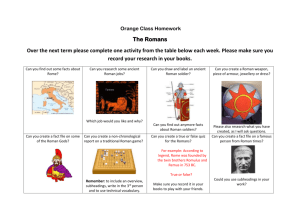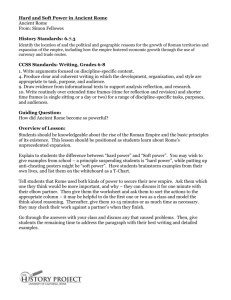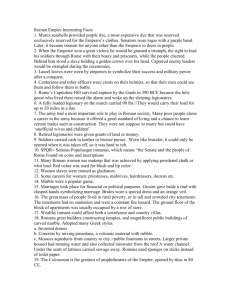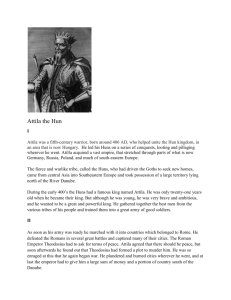Disasters of Ancient Rome
advertisement
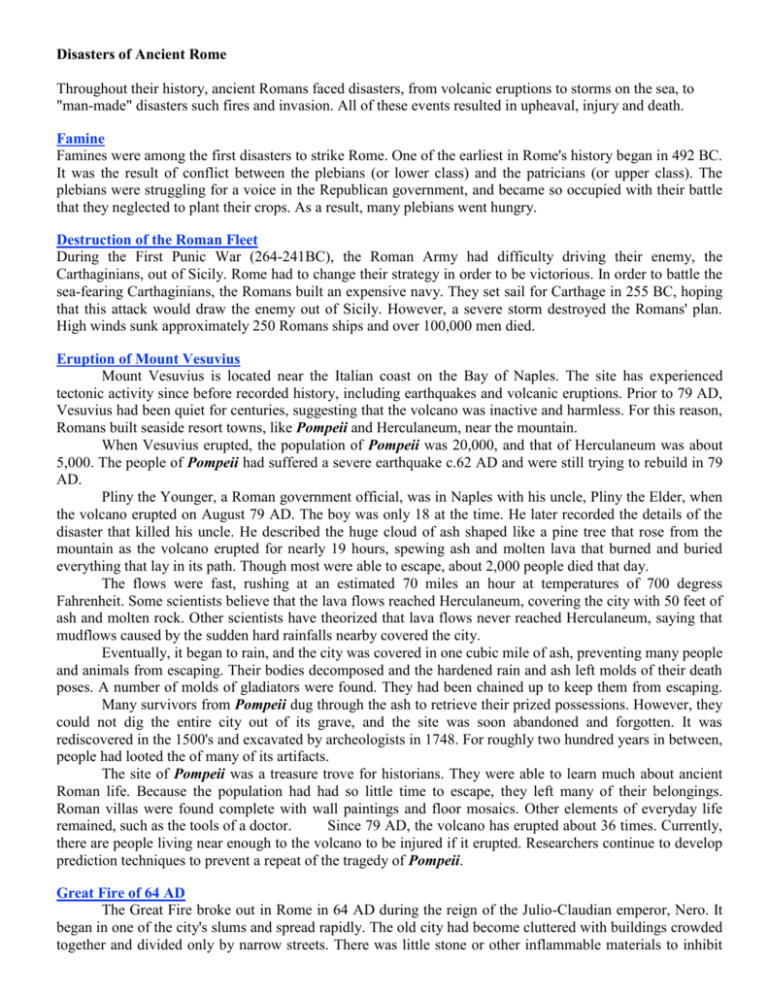
Disasters of Ancient Rome Throughout their history, ancient Romans faced disasters, from volcanic eruptions to storms on the sea, to "man-made" disasters such fires and invasion. All of these events resulted in upheaval, injury and death. Famine Famines were among the first disasters to strike Rome. One of the earliest in Rome's history began in 492 BC. It was the result of conflict between the plebians (or lower class) and the patricians (or upper class). The plebians were struggling for a voice in the Republican government, and became so occupied with their battle that they neglected to plant their crops. As a result, many plebians went hungry. Destruction of the Roman Fleet During the First Punic War (264-241BC), the Roman Army had difficulty driving their enemy, the Carthaginians, out of Sicily. Rome had to change their strategy in order to be victorious. In order to battle the sea-fearing Carthaginians, the Romans built an expensive navy. They set sail for Carthage in 255 BC, hoping that this attack would draw the enemy out of Sicily. However, a severe storm destroyed the Romans' plan. High winds sunk approximately 250 Romans ships and over 100,000 men died. Eruption of Mount Vesuvius Mount Vesuvius is located near the Italian coast on the Bay of Naples. The site has experienced tectonic activity since before recorded history, including earthquakes and volcanic eruptions. Prior to 79 AD, Vesuvius had been quiet for centuries, suggesting that the volcano was inactive and harmless. For this reason, Romans built seaside resort towns, like Pompeii and Herculaneum, near the mountain. When Vesuvius erupted, the population of Pompeii was 20,000, and that of Herculaneum was about 5,000. The people of Pompeii had suffered a severe earthquake c.62 AD and were still trying to rebuild in 79 AD. Pliny the Younger, a Roman government official, was in Naples with his uncle, Pliny the Elder, when the volcano erupted on August 79 AD. The boy was only 18 at the time. He later recorded the details of the disaster that killed his uncle. He described the huge cloud of ash shaped like a pine tree that rose from the mountain as the volcano erupted for nearly 19 hours, spewing ash and molten lava that burned and buried everything that lay in its path. Though most were able to escape, about 2,000 people died that day. The flows were fast, rushing at an estimated 70 miles an hour at temperatures of 700 degress Fahrenheit. Some scientists believe that the lava flows reached Herculaneum, covering the city with 50 feet of ash and molten rock. Other scientists have theorized that lava flows never reached Herculaneum, saying that mudflows caused by the sudden hard rainfalls nearby covered the city. Eventually, it began to rain, and the city was covered in one cubic mile of ash, preventing many people and animals from escaping. Their bodies decomposed and the hardened rain and ash left molds of their death poses. A number of molds of gladiators were found. They had been chained up to keep them from escaping. Many survivors from Pompeii dug through the ash to retrieve their prized possessions. However, they could not dig the entire city out of its grave, and the site was soon abandoned and forgotten. It was rediscovered in the 1500's and excavated by archeologists in 1748. For roughly two hundred years in between, people had looted the of many of its artifacts. The site of Pompeii was a treasure trove for historians. They were able to learn much about ancient Roman life. Because the population had had so little time to escape, they left many of their belongings. Roman villas were found complete with wall paintings and floor mosaics. Other elements of everyday life remained, such as the tools of a doctor. Since 79 AD, the volcano has erupted about 36 times. Currently, there are people living near enough to the volcano to be injured if it erupted. Researchers continue to develop prediction techniques to prevent a repeat of the tragedy of Pompeii. Great Fire of 64 AD The Great Fire broke out in Rome in 64 AD during the reign of the Julio-Claudian emperor, Nero. It began in one of the city's slums and spread rapidly. The old city had become cluttered with buildings crowded together and divided only by narrow streets. There was little stone or other inflammable materials to inhibit the spread of the fire. Tacitus, a Roman historian, recorded his version of what it was like to be in Rome that day. He told of the numbers of panicked women, children and elderly who were screaming and running. It was difficult to escape the fire because it was everywhere. Tacitus also told the story of people who kept others from putting the fires out. Dio Cassius also wrote about the fire a century after it happened. He told of chaos in the streets and of the thick smoke that made it hard to see. He noted that some soldiers set fire to the property of the fleeing residents. These soldiers hoped to steal from abandoned buildings. Dio Cassius described the image of Nero standing at the top of his roof, playing his lyre while the city burned. Nero provided some relief by temporarily opening his residence to those that had lost their homes. He paid for the reconstruction of most of the city's public buildings. However, Nero used the very land that was once the ghetto of the city as the site for his new home. The Domus Aurea (Golden Palace) occupied 120 acres of valuable Roman land. The palace grounds included gardens and a large lake. Many Romans were angry with Nero for wasting the land for his own pleasure. Emperor Vespasian later drained the lake and constructed the Flavian Amphitheater, a building used for public games. It was nicknamed the Coliseum because of the 120-foot bronze statue of Nero that Vespasian would not remove. Sack of Rome 410 AD By the fifth century AD, the Roman Empire had weakened considerably. Since the reign of Marcus Aurelius in the second century AD, barbarians had been attacking the borders with increasing force. The Roman economy was in trouble and the social structure was crumbling. When the Huns came out of Asia around 370 AD and pushed barbarian tribes like the Ostrogoths and Visigoths into eastern Europe, these Germanic tribes put more pressure on Rome. The Goths would either be given new lands or they would be forced to take them. Alaric was king of the barbarian tribe known as the Visigoths, which originated in the Balkans. Alaric had first been allied with Theodosius, the last Roman emperor of the east and west. They worked together to fight the Huns. When Theodosius died in 395 AD, the empire was divided between his two sons, Honorius in the west and Arcadius in the east. The change in Roman leadership also caused a change in the relationship between these Roman emperors and the Visigoths. At first, the Visigoths and Honorious were allied in a planned attack against Arcadius. Honorius did not pay Alaric with the supplies the barbarian tribe desperately needed, so Alaric attacked Rome in 409 AD. Before he reached the city, Honorius had fled to Ravenna, located on the northeastern coast of Italy near the Bay of Venice. Alaric besieged the city, but Rome would not surrender. Procopius of Caesarea, a Roman historian, described how Alaric devised a new plan. The Visigothic king sent a number of his young men and offered them as slaves to prominent Romans as a sign of peace. Alaric advised the men to serve the Romans willingly. He pretended to remove his army and then waited nearby while the Roman masters learned to trust their new slaves. Then one day, while the unsuspecting Romans slept, the Visigothic slaves gathered at the Salarain Gate, killed all the guards and then let Alaric and his army into the city. The Visigothic army looted the city and burned many buildings. However, because Alaric was a Christian and could appreciate good architecture, he commanded his men to show restraint and avoid damaging the most valuable buildings. After a few days, Alaric and his men left Rome and headed south. Once Rome fell, Honorious withdrew the troops from the Rhine and Danubian frontiers to defend Italy. This allowed the barbarian tribes to cross the northern borders and settle in the empire. The fall of Rome was an emotional blow to residents of the empire. The last time the city had fallen to an enemy was in 390 BC when the Gauls attacked. Rome had been the center of power for eight centuries and was a symbol of the empire's strength. Now it was evident that the empire was no longer as powerful as it had been at its zenith. By Sara Ann McGill Disasters of Ancient Rome; 2005, p1-2, 2p Great Neck Publishing





